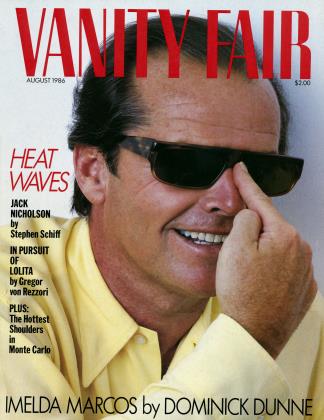Sign In to Your Account
Subscribers have complete access to the archive.
Sign In Not a Subscriber?Join NowKesey Does It
His new collection passes the acid test
Ken Kesey, whose antics as the messiah of mind-blow were documented down to the last psychedelic drop by Tom Wolfe in The Electric Kool-Aid Acid Test, hasn't exhausted all the tricks in his wizard kit. He may hunker in the mud of his Oregon farm, tending to sick critters, but his head still raids the clouds. In Demon Box (Viking), a beloved bull named Abdul has to be destroyed, and Kesey's autobiographical stand-in, Devlin Deboree (as in "debris"—Demon Box is a book about walking debris), notes that the rest of the herd forms a circle of grief around the spot where Abdul was murdered. "As time passes, this circle spreads larger. If one were to hang overhead in a balloon and take hourly photos of this outline of mourning, I believe it would describe the diffusing energy field of the dead animal." Demon Box deftly alternates camera angles, cutting from ground-level action to take an aerial view of the diffusing energy circles radiated by the dead, blasted sixties. Yet Ken Kesey is no Jack Kerouac, who turned his back on the past with a beery, sullen burp. In his own subdued, heads-up way, Kesey is still quizzing the cosmos.
A hodgepodge of stories, corn-pone fables, rooty-toot verse, and reminiscences filtered through a thin, teasing veil, Demon Box doesn't have the sustained clout of the Kesey cult classics Sometimes a Great Notion and One Flew over the Cuckoo's Nest. Essentially, Demon Box is an elaborate postscript to Acid Test, with Kesey/ Deboree emerging from the slammer after serving time for a marijuana bust and finding that the many-domed visions of the Blakean elect have gone kerplop. Working the farm in Oregon forces Deboree to forget about apocalypse now and lean a little more toward the real. The animals in Kesey's prose become more vivid than the people, more dignified in their purity of response and purpose. Even their despair is stoic. "My cows began to stand ass to the wind and stare bleakly into a worsening future, neither mooing nor moving." In a virtuoso paragraph, Deboree comes upon a lamb whom death has beautified into a devil's food cake, "decorated with elegant swirls and loops of red ant trails and twinkling all over with yellow jackets, like little candles." Decay, too, has its festive touches.
The people in Demon Box pick up interest when Deboree puts on his traveling shoes. A long scat on the making of Cuckoo's Nest and a psychiatric convention held at Florida's Disney World draws the reader right up to the spitting face of delirium. On board the monorail, Deboree sees an allAmerican family of six so embedded in their misery that they seem mere statues of their living selves. The implication is that this glum repression serves as the breeding ground of insanity.
From this frieze of Domestic Grief, Deboree pays call on the brave new world of damage control for head cases. Display booths at the convention show off all the latest devices. "There were unrippable pajamas with padded mittens to prevent the hallucinator from plucking out an offending eye. There were impact-dispersing skullcaps for the clumsy, disposable looparound mouthpieces for the tongue gnashers, lockfast maxi-Pampers for the thrashing incontinent. . . " If delirium can't be tamed, it can be muffled, diapered. Most of the booths, however, are hosted by pharmaceutical companies hawking tranquilizers and muscle relaxants—a chemical bazaar which inspires the convention's keynote speaker to declare that these companies are no better than munitions dealers. Pills are their bullets.
Aside from that keynote speaker—a wizened, genius Dr. Strangelove—the star of this, the title chapter, is a strung-out space cadet confined briefly to the sanatorium where Cuckoo's Nest is going to be filmed. She has her own method of dodging the pharmacological bullet: "I cheek the tranqs," she confides. To demonstrate, she tucks a piece of glass in her mouth, secretes it in her cheek, and, showing her teeth, spits the shard "tinkling across the new tile." Kesey prefers spitters to swallowers, and our last glimpse of this astral glider is amused but affectionate. "Without another word she turned on her heel and stalked unaided past the waiting flunky, across the lobby, and straight out the door toward the sedan, majestically, or as majestically as possible for a knobby-jointed maybe-crazy halfgreen-haired nearly-completely-blind girl thing from another dimension." A loose book with solid pockets of writing, Demon Box suggests that there's no reason to follow winged crazies into another dimension. Things are weird enough here.
James Wolcott
 View Full Issue
View Full Issue


















Subscribers have complete access to the archive.
Sign In Not a Subscriber?Join Now